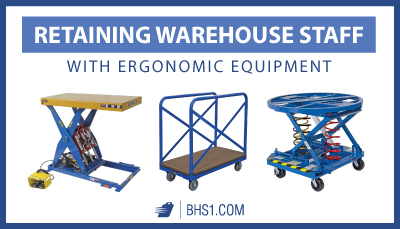We use cookies to make your experience better. To comply with the new e-Privacy directive, we need to ask for your consent to set the cookies. Learn more.
Retaining Warehouse Staff with Ergonomic Equipment
Hiring and retaining warehouse staff could be the next big challenge facing the logistics industry as a whole. And while you might have read a lot about the ongoing scarcity of truck drivers, the entire supply chain, from start to finish, is starting to compete for the best workers to stay ahead of the curve. These new conditions could hit unprepared warehousing operations hard. Consider the following points:
- In 2017, the unemployment rate in the U.S. dipped below the long-term natural rate of unemployment — the point at which the demand for jobs is at parity with the number of qualified job-seekers. Dipping below that number is a pretty clear sign of impending labor shortages.
- By the end of last year, the World Bank had published a report that found there aren't enough skilled workers in the logistics sector to keep up with the projected 5 percent growth of the global industry.
- In fact, the report noted "a general perception across the logistics sector that qualified logistics-related labor is in short supply on all occupational levels in both developed and developing countries."
Some experts are hoping automation will fill the gap. Others, however, are taking cues from the one of the World Bank report's findings — that the warehousing industry doesn't have a terrific reputation among potential employees — and they're working to change that reputation, one ergonomic intervention at a time.
Key Areas for Ergonomic Improvements Within Warehouses and Distribution Centers
For ergonomic equipment to really improve worker experience, thereby driving retention, it must assist in daily tasks, removing the uncomfortable motions that contribute to staff dissatisfaction and, too often, musculoskeletal injuries.
Here are a few examples of changes that could make all the difference for employees considering whether to stay or go:

- Use Pallet Carousel & Skid Positioners while building and unpacking pallets. Working with pallet loads can get pretty awkward over time. As you build a pallet, the surface of the work climbs higher, so you begin in a crouch. Meanwhile, you have to stretch and reach across the surface of the pallet load. Through the course of a whole shift, these repetitive motions can lead to injuries.
- Provide variable-height workstations. For order packing and other manual tasks, the level of the work makes all the difference over the course of the workday. And while the ergonomically ideal range sits between an employee's shoulders and knees, directly in front of the torso, obviously, staff members aren't all the same height.
- Offer specialized carts designed for different material types. In a material handling application, there's not much more annoying than trying to transport a sheet of steel or a piece of drywall with a regular cart. When you give your staff the right tools for the job, their work becomes less frustrating, less dangerous, and ultimately, more attractive.
Pallet Carousel & Skid Positioners keep pallet-building and unloading tasks at the same level, close to the worker's body. A 360-degree turntable easily brings the whole surface of the work area into easy reach. After a full day of building pallets, it's easy to feel the difference.
That's where Scissor Lift Tables come into play. These heavy-duty steel tables are designed for tough industrial environments, and they make ideal variable-height workstations for the warehouse. Choose a variety of tabletop attachments to integrate Scissor Lift Tables into existing order pathways.
In the case of sheet materials, from window panes to slabs of stone, provide staff with a designated Sheet Material Rack or Panel Cart to simplify handling.
These examples don't even begin to cover the range of improvements available to today's material handling applications. Besides, the full list of ergonomic improvements would be different at every facility.
One thing is true for the whole warehousing industry, though: Providers may soon find themselves competing for the same workers, and the employer that offers the safest, most comfortable workplace will have the edge.
References:
Lopez, Edwin. "Logistically Minded: A talent shortage pervades the supply chain." SupplyChainDive. Industry Dive, 5 May 2017. Web. 11 Dec. 2017.
McKinnon, Alan, Christoph Flöthmann, Kai Hoberg, and Christina Busch. 2017. Logistics Competencies, Skills, and Training: A Global Overview. World Bank Studies. Washington, DC: World Bank. doi:10.1596/978-1-4648-1140-1. License: Creative Commons Attribution CC BY 3.0 IGO
